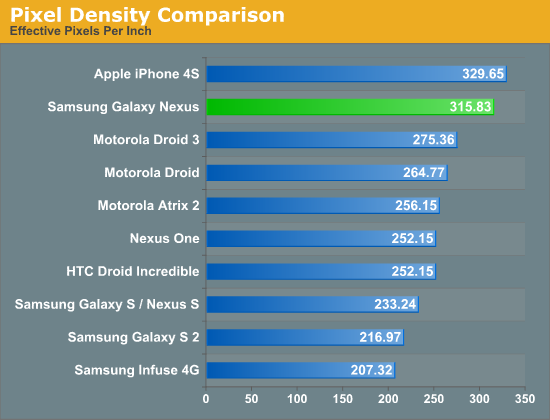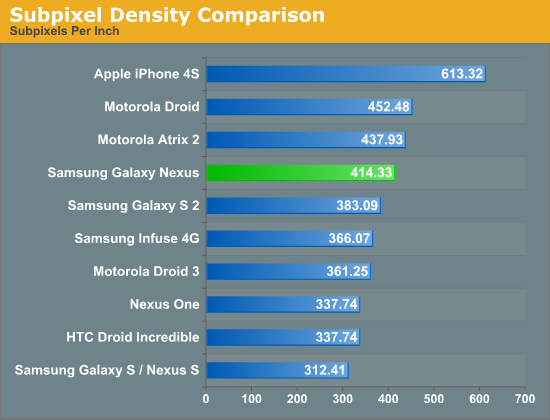Confirmed: Galaxy Nexus Includes PenTile
by Brian Klug & Jason Inofuentes on October 21, 2011 12:58 AM EST- Posted in
- Smartphones
- Samsung
- Ice Cream Sandwich
- Mobile
- AMOLED
- galaxy nexus
Though we've learned a lot about the Galaxy Nexus specifications already, one of the things that has remained a question thus far is whether its 4.65" 720p HD Super AMOLED display uses an RGB subpixel rendering layout or PenTile. We've now confirmed that the Galaxy Nexus display does in fact use RGBG PenTile, like all the Nexus devices to date. This isn't super surprising considering that Samsung has been pretty good about adhering to all the monikers it has gradually been tacking onto AMOLED. There are a number so far - 'super' connotes an optically bonded panel and digitizer stack, 'plus' connotes an RGB stripe, and now 'HD' connotes, well, 720p. HD Super AMOLED lacks Plus, and thus isn't an RGB stripe.
The next question is just what 4.65" HD Super AMOLED will look like, or whether the presence of PenTile will be as noticeable as previous AMOLED phones like the Nexus S / Galaxy S or Nexus One where it was arguably very noticeable. That said, at some subpixel density it should become difficult to impossible to notice PenTile's presence, it's just a matter of exceeding human visual acuity. Having not seen the Galaxy Nexus in person yet and given the absence of good macro shots of the display, we have put together a numerical comparison pitting the Galaxy Nexus panel up against some other common smartphone displays.
First up is a quick plot of the effective pixel density of some popular displays. Stated another way, this is the pixel density based on the manufacturer's stated logical resolution, which is also the resolution of Android's render target for the phone.

Note that this is the traditional means of reporting pixels per inch that we've published before. However, using this metric is just a bit misleading since it doesn't take into account the difference between 2 subpixel-per-pixel RGBG or RBGW PenTile versus the 3 subpixel-per-pixel RGB stripe. To make for an effective comparison, we've put together another plot where we take into account the presence of PenTile and report subpixel density.

Here things still look pretty good for the 4.65" HD Super AMOLED display, putting it just north of SGS2's Super AMOLED Plus display with an RGB stripe. I wager that if you were satisfied with the pixel density of SGS2 that the pixel density Galaxy Nexus actually won't be off-putting despite the presence of PenTile. In addition, hopefully some of the UI design considerations that come along with using PenTile (no vertical 1 pixel thick elements) have been taken into consideration from the outset for Ice Cream Sandwich. For true subjective impressions however, we'll have to wait and see.
Source: Data










152 Comments
View All Comments
Taracta - Friday, October 21, 2011 - link
A 2x2 one square inch screen with RGB layout:RGB RGB
RGB RGB
Would give you 2ppi or 6spi NOT 4ppi or 12spi, this is because for every inch across, horizontal, there are 2 pixels and for every inch up or down, vertical, there are two pixels. You will notice that sub pixels are totally dependent on the whole pixel and you have to could the sub pixels in each pixel and not just the leading sub pixel.
The 2x2 one square inch layout of RGBG pentile arrangement it is a little more complicated:
RG(B)GR
BG(R)GB
Would give you 2ppi or 5spi, the center sub pixel is shared by both pixels and it is never the G(reen) in the current usage.
I believe that you are correct in stating that to calculate spi you would x3 for RGB, for both vertical and horizontal, and for the pentile RGBG it is approximately x2, FOR THE HORIZONTAL MEASUREMENT and x3 for the VERTICAL MEASUREMENT.
Chinpokomon - Friday, October 21, 2011 - link
Maybe it doesn't matter for the purpose of this discussion, but the penile layout is actually more like:RG BG
BG RG
sjael - Friday, October 21, 2011 - link
"Also, explain how it is not fair to compare RGB PenTile to RGB based on the true subpixel density of the two displays? "I didn't say density though, I said just the number. What I mean is that PenTile has gotten a lot of bad press because now everyone knows* that PenTile has "two subpixels per pixel instead of three" and is thus always horribly inferior. However in most cases (that aren't *very* small lines on contrasting backgrounds :P) there's no noticeable difference (unless you have that particular mutation,) and especially in this case it allows a much higher resolution than was possible with RGB Stripe.
Even in the Galaxy S, I assume the relatively low pixel density was down to yields at the time, and that density allowed them to put into phones a stunning OLED screen that nobody really had a problem with because no one knew there was something to criticize yet.
I guess I'm just tired of reading all day about how Samsung/Google "cheaped out" on the screen. From every angle I've seen, it appears to be right up near the limit of Samsung's current AMOLED printing technology.
I do agree on 315ppi PenTile probably not being noticeable though - I would be very surprised if any of PenTile's critics could tell it apart from RGB stripe at that density.
Brian Klug - Friday, October 21, 2011 - link
I think we're actually in agreement then, PenTile actually has a lot of promise as far as different subpixel rendering layouts go, the problem is that the two most popular implementations thus far have had subpixels that were larger than visual acuity (well, at least mine :P), and thus don't exceed it enough to deliver the promise of - same effective resolution with fewer subpixels.I believe that in this case, with 720p and 4.65", it might finally be good enough to emulate that higher resolution RGB stripe. I definitely agree that Samsung/Google didn't cheap out here, if anything this should illustrate that the subpixels in RGBG 720p PenTile should be smaller than those in the RGB SGS2, and likely are made with a correspondingly smaller geometry on their mask - eg more advanced. I guess that's my point with the line where I state it's above SGS2, it really should be better.
-Brian
miketlo - Friday, October 21, 2011 - link
You beat me to the exact same explanation while I was typing mine up. +1 :)thegadgetlife.com.au - Friday, October 21, 2011 - link
Well instead of talking about horizontal and vertical resolutions, can you tell me what's wrong with the following reasoning:A 100×100 pixel image that is printed in a 1-inch square has a resolution of 100 pixels per inch (PPI). (from wikipedia)
Since each pixel in RGB has 3 subpixels, for RGB layouts you you can write this as:
A 100×100 pixel (OR 300x300 subpixel) image that is printed in a 1-inch square has a resolution of 100 pixels per inch (PPI) OR 300 spi. (from wikipedia)
In the above example, there are 10,000 pixels per square inch. And all 10,000 pixels have 3 sub pixels. So the subpixel count is 100*3 X 100*3, NOT 100*3 X 100.
If you represent a pixel as X, the layout of the 2x2 one square inch display example I gave above is:
X X
X X
if you replace each pixel by its RGB subpixels, it becomes
RGB RGB
RGB RGB
or for RGBG, it becomes:
RG BG
RG BG
I may be completely wrong here, but still want to figure out how.
Brian Klug - Friday, October 21, 2011 - link
The problem is that your definition and layout is correct, but you aren't actually doing the math per-se.Eg:
sqrt(6^2 + 2^2)/1 = 6.32
sqrt(4^2 + 2^2)/1 = 4.47
In both cases, there is one horizontal subpixel per logical pixel. The problem is that the square in there throws off that scalar scaling.
It's a case of, the problem is being setup properly, but not mapped to math properly, I think.
-Brian
InternetGeek - Friday, October 21, 2011 - link
I'm not an expert, but I think that multiplying by 3 the dimensions just because an RGB pixel has 3 subpixels is wrong. I believe it depends on the arrangement of the 3 subpixels.So if the arrangement is one pixel as a kind of pivot with one on top and one on the side; you would multiply by two to obtain the number of vertical subpixels and by one to obtain the number of horizontal subpixels.
In PenTile, the subpixels are arranged horizontally, that is only one vertically and 3 horizontally. So vertically the number is not changed, horizontally the number is multiplied by 3.
dukepeter - Friday, October 21, 2011 - link
"In the above example, there are 10,000 pixels per square inch. And all 10,000 pixels have 3 sub pixels. So the subpixel count is 100*3 X 100*3, NOT 100*3 X 100."actually, IT IS 3*100x100. each RGB pixel is composed of 3 sub-pixels, not 9.
100*3x100*3=90,000, not 30,000 as it should be...
sjael - Friday, October 21, 2011 - link
Exactly, case closed.And I really do need to compliment you guys - you are the only tech site I've ever used where the writers actually engage in dialogue with commenters. For that reason Anandtech is the only site I actually take the time to comment on. Big thumbs up.